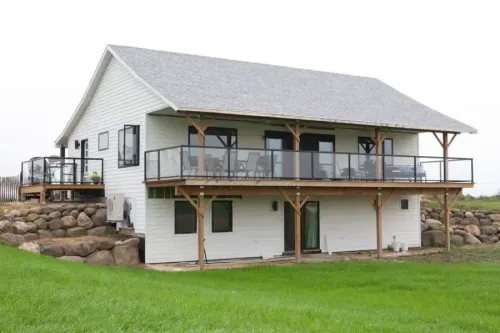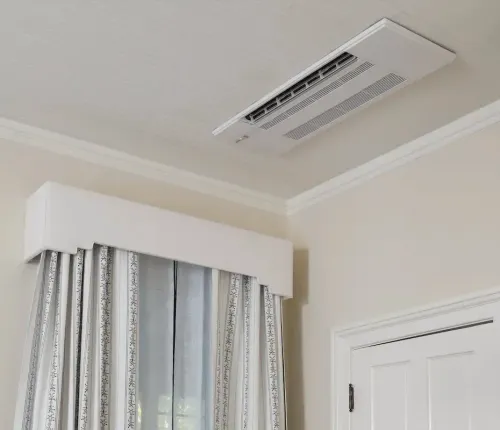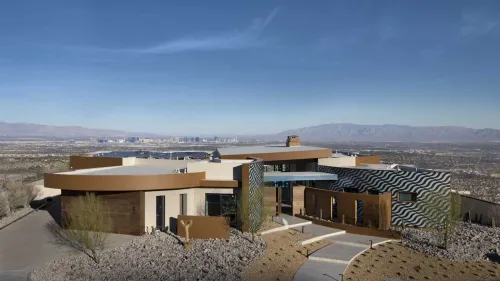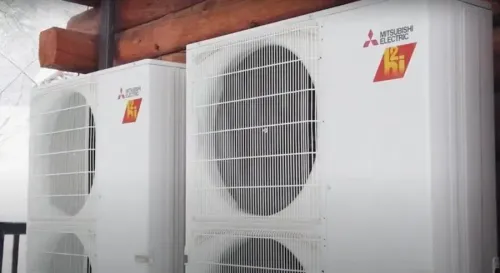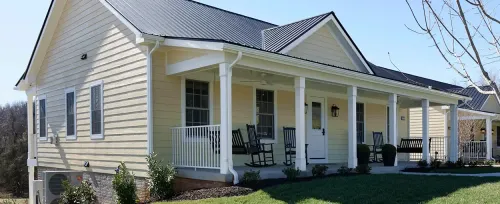Project Location: Hollis, New Hampshire
Completion Date: April 2013
Challenge
Finding an HVAC system that could meet Passive House’s stringent standards for energy efficiencySolution
A Mitsubishi Electric HyperHeating (H2i®) systemResult
Energy efficiency, cost savings and sustainability combine to make Hollis Montessori School the country’s first Passive House certified independent school
The Hollis Montessori School (Hollis Montessori), Hollis, New Hampshire, is the first independent school in the country to receive Passive House certification. This certification denotes the school’s extreme energy efficiency and means the facility has met rigorous energy-saving standards. The certification also hints at the thoughtful education taking place inside the classroom walls. For example, students are welcome to interact with the facility’s various energy-saving systems. Students have been particularly interested in the equipment on the walls that keeps their classrooms comfortable and their school compliant with Passive House standards. That equipment is part of a Hyper-Heating INVERTER™ (H2i®) system from Mitsubishi Electric.
Hollis Montessori is housed in two separate sites: a brand-new building with 10,000 square feet of space and a renovated apple pie factory with 4,900 square feet of space. For both buildings’ design, the goal was to create the best possible setting for learning. In the case of the brand new building, that meant Passive House certification.
Jordan Goldman, principal, ZeroEnergy Design, Boston, led the Passive House consultation and HVAC design team. Goldman explained the draw of Passive House for the new building: “Everyone talks about energy efficiency and carbon footprint. You get these pieces with Passive House, but it’s also about better indoor air quality, thermal comfort and natural indoor light. This is especially true for a school because there’s a correlation between these three factors and student performance. The healthier the air, the healthier the student. The healthier the student, the fewer days of school they miss. The fewer days of school they miss, the better they do in school. And then oh, by the way, Passive House will save you 90 percent on your heating energy.”
With sights set on Passive House certification, the team’s HVAC search turned to heat pumps. “A conventional system like a boiler would have been dramatically oversized for the facility’s low heating demand, which would lead to inefficient operation and increased system cost,” Goldman said. “Keeping the energy level down is the core of Passive House,” added the team’s Architect David Ely, Aia, owner, Windy Hill Associates, New Boston, New Hampshire.
Ely also favored heat pumps for their “minimal impact on the building. We didn’t want ductwork; it’s ugly and it takes up space. With heat pumps, all we had to do was bring in condensate lines.” Frank Grossman, president, board of directors, Hollis Montessori, explained that “having no ductwork also helped save money. We considered geothermal heat pumps, too, but air-source heat pumps were less expensive because of the ductless design and lack of drilling.”
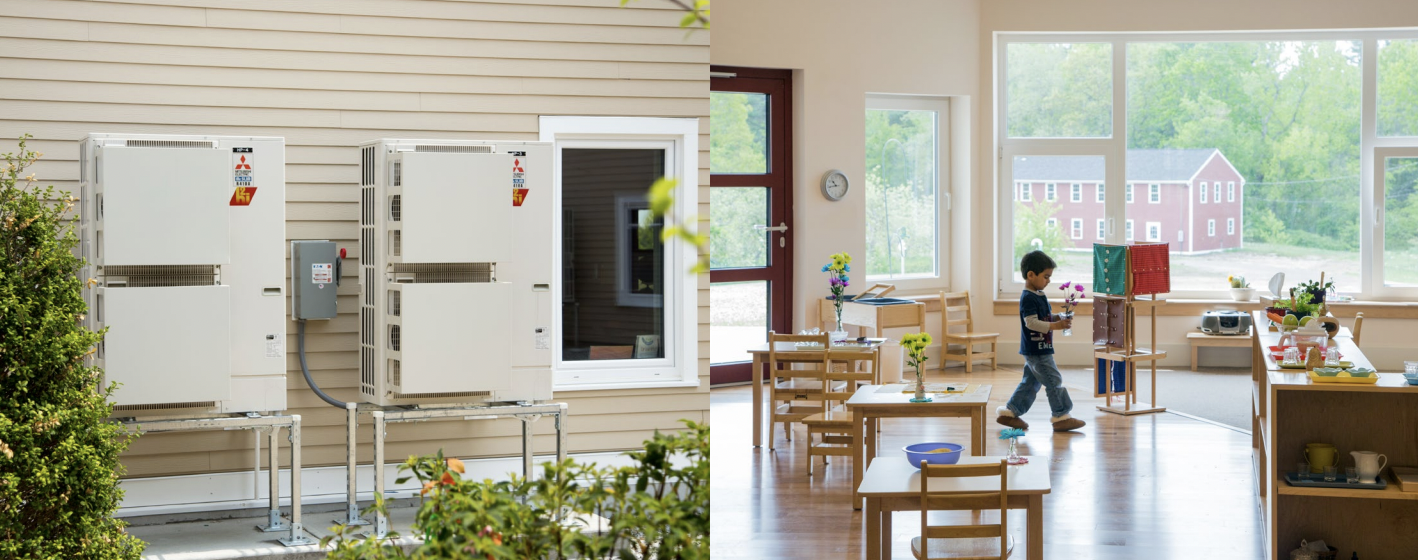
Mitsubishi Electric was selected as the brand of choice because “the availability of hyper-heating was really important given the rough northeast winters. We also like the track record of performance and reliability with Mitsubishi Electric, and their extensive service network relative to other manufacturers,” said Goldman. Grossman added, “Mitsubishi Electric also wouldn’t need backup heat.”
Installation “went very smoothly,” said Grossman. Outdoor units were put on stands to maintain efficiency during New Hampshire’s snowy winters. Indoor units were mounted to the wall of each 1,400-square-foot classroom to “simplify the distribution without sacrificing any thermal comfort at all,” said Goldman.
Grossman explained that the school “also added sub-panels throughout the building where students can find out what energy their classroom is using compared to other classrooms. Students occasionally ask for the data, which they can see on tablets. It makes them both excited and curious. They try to figure out why one classroom is using more energy than another. The upper elementary kids also do units on energy and are educated about the heat pump system. They’re very interested in how, on a cold day, you can take that cold air and turn it into heat.” In addition to serving as a learning tool, the HVAC system has provided reliable cooling and heating for two years now. Grossman said, “We were hesitant about heat pumps at first—whether they would keep up with the northeast winter. But we were told these Hyper-Heat heat pumps from Mitsubishi Electric could handle cold temperatures even on negative days and still produce the right amount of heat. I’ve absolutely found this to be true; the units work nicely to produce even heat. Pretty much anywhere you go in the building, it’s the same temperature. This is especially nice for the teachers, who can just work. They don’t have to think much about adjusting the temperature.”
The heat pumps are also keeping any humidity in check. Ely said, “When a building like this gets closed up and unused with no systems running, as happens over the summers, humidity can build up. Floor boards can warp. We’re mitigating that by running these units on a low setting, offering dehumidification.”
Hollis Montessori’s success has extended to their utility bills, as well. For the Passive House-certified building, the previous year’s electricity bill was $4,500. That covers HVAC, lighting, computers, hot water for hand washing and small classroom kitchens with appliances. Goldman said, “Compared to other schools, that’s an 85 percent energy savings.” Those savings add up quickly: “It cost us about 10 percent more to put in passive design, but we expect a payback of just three years,” said Grossman.
Indeed the entire Hollis Montessori design team, the teachers, the students and the surrounding community have been very supportive of the project. Energy efficiency groups have even held meetings at the school, and architects have given tours. The larger world of green building has also felt the buzz. As a country, we now have our first certified Passive independent school. This is not just a big accomplishment; it’s an important step toward large-scale passive construction.
Project Team
- Facility: Board of Directors, Hollis Montessori School
- Architect: Windy Hill Associates, New Boston, New Hampshire
- Energy Consultant: ZeroEnergy Design, Boston
Equipment Installed
- (18) PUZ P-Series Outdoor Units
- (4) PKA Wall-mounted Indoor Units
- (1) PEAD Ceiling-concealed Ducted Indoor Unit


